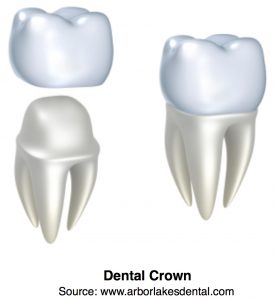Cosmetic Dentistry
Cosmetic dentistry is the general term used to describe what dentists do to improve your appearance. An improvement in your appearance increases self esteem. That, in turn, can improve overall health.
The Concerns
People often complain that their teeth are crooked, chipped or broken from accidents. They are self-conscious about visible natural imperfections. They can see decay and stains. Fillings are showing. Continue reading
White Fillings
There are two general types of white fillings: ceramic and composite. In truth so-called white fillings are tooth-coloured)
Composite Fillings
Composite fillings represent an ever-evolving technology to repair and restore teeth in a way that is both strong and pleasing in appearance. The word composite implies that the constituents of these fillings are complex. Continue reading
Crowns
Crowns are an excellent way to repair teeth that have been broken, or have been weakened by decay or a very large filling. A crown could be made for a number of other reasons, for example:
been weakened by decay or a very large filling. A crown could be made for a number of other reasons, for example:
- you may have a discoloured filling and would like to improve the appearance of the tooth.
- you may have had a root filling and need a crown to protect what is left of the tooth.
- it may be the part of a bridge that is cemented to a natural tooth.
The New Patient Complete Dental Examination
If your first visit to Growing Beautiful Smiles was for some purpose other than a New Patient Complete Dental Examination, then once that other bothersome issue is disposed of, a complete dental exam should become a priority.
Sometimes people ask us why this is necessary. Continue reading
Removal of Mercury Fillings
The mainstream in dentistry staunchly defends the use of mercury fillings. Historically the mainstream became the mainstream by winning a nasty professional debate (“the amalgam war”) in the eighteen-fifties.
What I refer to as “mercury” fillings, are what most people call “silver fillings” and what the dental profession calls “dental amalgam fillings.” (Actually we call a filling a “restoration.”) A dental amalgam filling leaks small amounts of mercury as a gas which you inhale 24/7. Your body eliminates some of it, but enough remains so that in most people, it accumulates over the years.
Suspicion that mercury leaked from amalgams launched the amalgam war which in turn re-defined the way the dental profession organized itself and, it seems, significantly crippled its ability to think. Clear evidence that mercury was leaking from amalgams has existed for almost a hundred years. Continue reading
Non-Surgical Gum Treatment
Before we get into non-surgical gum treatment, let’s clear up some vocabulary. We need to understand what gum disease is. We need to get an idea of what surgical treatment is about. Surgery is very commonly recommend by the mainstream.
The Vocabulary
We dentists and hygienists have really messed up communications in this area. Continue reading
Dental Sealants
Dental sealants are a plastic (composite) coating applied to vulnerable areas of teeth to make decay less likely to get started.
They are only applied to the back teeth – the molars and premolars. These are the teeth that have ‘pits’ (small hollows) and ‘fissures’ (grooves) on their biting surfaces. Therefore, they are also known as pit and fissure sealants. Continue reading
Ozone Therapy
One of the most important problems in dentistry is infection control. The oral cavity is like an ocean full of microorganisms normally living in balance with the entire body. Under certain conditions, pathogenic (“disease causing”) micro-organisms can become the dominant life forms, thus creating what is known as infection. These pathogenic microorganisms live together to form a biofilm made up of bacteria, viruses, fungi, and protozoa.
If we were to treat this condition with drugs, each of these “disease causing” types would likely need a different drug to eliminate its dominance. Continue reading
The “Re-Care” Appointment
A Re-Care appointment means that after some agreed-upon interval, we are following up Continue reading
Oral Hygiene Instruction Dilemmas
by Bruna Mucaj, RRDH.
To an enormous extent, dental disease is preventable. But by far the most effective prevention is done by the teeth’s owners, (or the owner’s parents) – not by the dental profession and not by the government! We believe that of all the services we provide, Oral Hygiene Instruction is right up there with Nutritional Counselling as the most valuable. Alas, several factors conspire to frustrate our efforts. Continue reading
